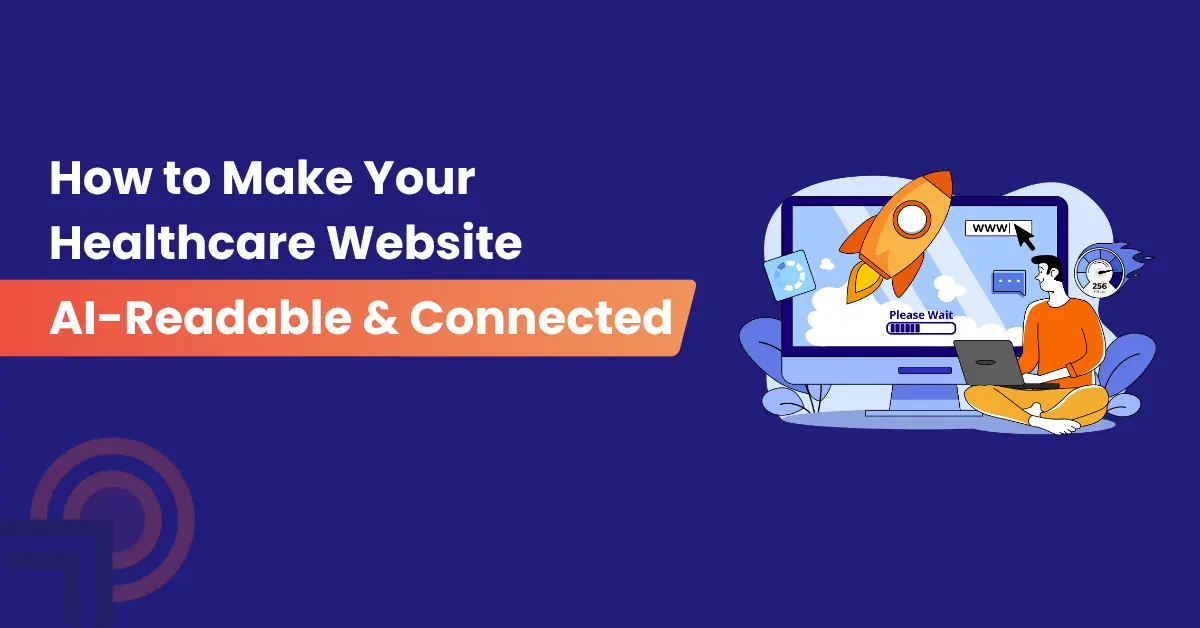Think about this: When people are looking for a doctor, a hospital, or medical information, what are they typing into Google? Not as much as you think. Patients are utilising AI-driven assistants, voice-assisted devices, and conversational search tools to obtain immediate, personalised answers. If your health website is not “AI-readable” and you are not well “connected,” you could be lost in a rapidly changing digital world.
AI does not “read” content in the same way a human does; it scans, interprets, and extracts structured information to respond quickly and reliably. For healthcare organisations, having a simple, static website is no longer sufficient. You need content structure and systems to connect to patient systems, with an overarching connectivity across the digital environment. In this article, we will share seven action-oriented examples to make your healthcare website more “AI-readable” with “AI-connected” capabilities.
5 Steps to Turn Your Healthcare Website AI-Readable and Connected
In an AI-first search world, your site needs to focus on structure, clarity, and interoperability to remain visible and valuable. Below is how to accomplish that:
1. Implement Structured Data (Schema Markup)
Schema markup is used by AI systems to identify and classify your content. For healthcare websites that serve patients, using schemas like “Physician or Doctor,” “Hospital,” or “Medical Clinic” enables AI tools to retrieve accurate details about your doctors, departments, treatments, and more. This helps ensure that your information is displayed in knowledge panels, featured snippets, and AI-augmented search answers.
2. Optimize Content for Natural Language Queries
Doctors often use everyday, conversational terms in searches, such as “Which dermatologist near me accepts insurance?” rather than “dermatologist insurance city.” Building content using FAQs, Q&A pages, and a simple explanation of what the medical term means provides AI tools with content that yields clearly identifiable, accurate answers that align with real patient questions.
3. Integrate with Voice Search Platforms
The use of voice search is on the rise, and this trend is particularly evident in the healthcare sector. Patients frequently ask for answers in real-time, for example, “find urgent care near me that is open right now.” To keep up with this form of search, simply add a little boutique to metadata, headings, and on-page content for conversational keywords. Then, at creation time, produce content that can be ‘heard’ by Alexa, Siri, or Google Assistant.
4. Create Interoperable Digital Connections
AI will produce the best results when it can connect data between different systems. Your website should connect with the appointment booking system, hospital patient management systems, and any telemedicine platform. This way, when AI directs patients to request a visit with you, they will be able to immediately take action to secure their visit by booking an appointment online, accessing their medical records, or securely chatting with a provider.
5. Ensure Mobile-First and Fast Load Speed
Patients are searching for healthcare access on their mobile devices. AI platforms favour mobile-first sites and will rank them higher because the platform provides a more seamless experience when the website loads faster and is easy to navigate. Activities such as compressing images, adjusting the site architecture, and professionally creating responsive sites to improve user experience also means improving AI discoverability.
Benefits of Building an AI-Readable and Integrated Website
Creating a website that is readable by artificial intelligence systems isn’t just about technology. It is about remaining open, trusted, and relevant for the patients of today. Here’s why it impacts:
1. Higher Visibility in AI-Powered Search
With structured content and schema, it becomes easier to highlight your practice in voice replies, featured snippets, and conversational search results powered by AI.
2. Improved Patient Experience
Your website is now the number one destination because we can connect it to your scheduling system and patient portal, allowing patients to search, see, and book services on the spot.
3. Stronger Trust and Credibility
The use of verified medical content, credentials, and real patient testimonials demonstrates authority, increasing trustworthiness with both patients and AI algorithms.
4. Increased Patient Engagement
Features like chatbots, FAQs, and online booking keep patients engaged while providing fast solutions and increasing the likelihood of return visits and loyalty.
5. Competitive Edge in Your City
Most healthcare websites are still rudimentary. By creating a connected website, you set yourself and your clinic or hospital apart in the increasingly modern, AI-friendly environment. You can effectively appeal to patients who value access and convenience.
Conclusion
AI is speedily changing the ways patients search for and connect with healthcare providers. An online, searchable webpage can list your services; however, it’s an AI-discoverable, connected platform that ensures your practice will be discovered, trusted, and engaged in a digital-first healthcare environment.
Here at Thanksweb, we help healthcare providers AI-proof their website to navigate the AI future with strategies designed to improve patient engagement. From implementing various schemas and voice search optimisation to API and patient portal environments, we deliver solutions to improve your online presence and engage patients.
If you want a thriving clinic or hospital in a landscape driven by AI-powered searches, contact Thanksweb today. Together, we will develop a healthcare website that informs, connects, engages, and converts.

